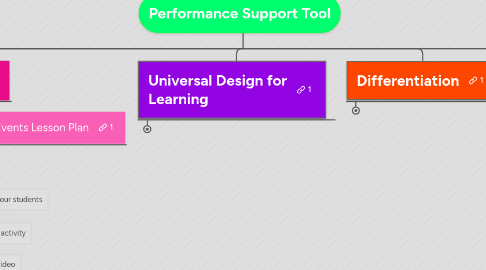
1. Analysis
1.1. Learner Analysis
1.1.1. Accomodations
1.1.2. ELLs
1.1.3. Prior Knowledge / Strengths and Weaknesses
1.1.4. Learning styles
1.1.5. Cultural relevance / student interests
1.2. Context / Resource Analysis
1.2.1. Classroom demographics / school culture
1.2.2. Funding and policies
1.2.3. Materials / Tech
1.3. Content / Task Analysis
1.3.1. Research content / standards
1.3.2. Organize content / standards
1.3.2.1. What is important to teach?
1.3.3. Approach towards teaching content
1.3.3.1. What skills are prereqs for the content?
1.3.3.2. Does everything you're doing have purpose?
1.3.3.3. How will you address differentiation?
2. Design
2.1. ABCD Objectives
2.1.1. Audience
2.1.1.1. Who are your learners?
2.1.2. Behavior
2.1.2.1. Observable perofrmance
2.1.2.2. What do you expect your student to do?
2.1.2.3. Words to use: write, identify, construct, etc.
2.1.2.3.1. http://bit.ly/1n8BTwI
2.1.3. Condition
2.1.3.1. Given...
2.1.3.2. What are your students using to complete the behavior?
2.1.4. Degree
2.1.4.1. With 90% accuracy...
2.1.4.2. How well does your student have to perform the behavior?
2.2. Terminal Objectives
2.2.1. What students will be able to know or do at the end of the lesson
2.2.2. Objectives should ask students to think on different levels of Bloom's taxonomy.
2.3. Enabling Objectives
2.3.1. The prerequisite components needed to complete the terminal objective.
3. Development
3.1. Gagne's Nine Events Lesson Plan
3.1.1. Gain attention
3.1.1.1. engage your students
3.1.1.1.1. an activity
3.1.1.1.2. a video
3.1.2. Inform learners of objectives
3.1.2.1. Today we will learn...
3.1.3. Stimulate recall of prior learning
3.1.3.1. Yesterday we learned...
3.1.3.2. KWL chart
3.1.4. Present the content
3.1.4.1. This is the lesson!
3.1.5. Provide guidance
3.1.5.1. Together we will practice...
3.1.6. Elicit performance
3.1.6.1. Now do this on your own!
3.1.7. Provide feedback
3.1.7.1. Circulate!
3.1.8. Assess performance
3.1.8.1. Formative assessment
3.1.8.1.1. exit slip
3.1.8.1.2. short quiz
3.1.9. Enhance retention and transfer
3.1.9.1. more practice
3.1.9.2. different scenarios
4. Universal Design for Learning
4.1. Provide Multiple Means of Representation
4.1.1. Provide options for perception
4.1.1.1. Customize the info!
4.1.1.2. Have alternatives for visual and auditory input!
4.1.2. Provide options for language, mathematical expression and symbols
4.1.2.1. Clarify vocab, syntax,symbols and structure
4.1.2.2. Promote understanding across languages
4.1.2.3. Illustrate through multiple types of media!
4.1.3. Provide options for comprehension
4.1.3.1. Activate or supply background knowledge
4.1.3.2. Highlight patterns and big ideas!
4.1.3.3. Maximize transfer and generalizations
4.2. Provide Multiple Means of Action and Expression
4.2.1. Provide options for physical action
4.2.1.1. Vary methods of response
4.2.1.2. Provide access to tools and assistive technology
4.2.2. Provide options for expression and communication
4.2.2.1. Use different types of media for communication, construction and composition.
4.2.3. Provide options for executive function
4.2.3.1. Support goal-setting techniques and strategic planning
4.3. Provide Multiple Means of Engagement
4.3.1. Provide options for recruiting interest
4.3.1.1. Make sure options are relevant culturally and to students' interests
4.3.2. Provide options for sustaining effort and persistence
4.3.2.1. Vary demands to challenge your students
4.3.2.2. Make sure goals are salient to kids
4.3.2.3. MASTERY-ORIENTED feedback
4.3.3. Provide options for self-regulation
4.3.3.1. Teach coping skills and strategies
4.3.3.2. Help kids develop self-assessment goals
4.3.3.3. Have high expectations for students!
5. Differentiation
5.1. Content
5.1.1. Differentiate your content for the variety of learners in your classroom
5.1.2. Use a variety of different types of content: audio, worksheets, lectures, etc.
5.2. Process
5.2.1. How are the students taking in the information?
5.2.2. Make sure the process of student learning is varied - not everyone learns the same way!
5.3. Product
5.3.1. What are you expecting students to produce?
5.3.2. Vary your assessment tools and your activities
5.4. Environment
5.4.1. Make sure you utilize your space effectively.
5.4.2. What are your expectations? What is the emotional climate of your classroom?
6. Understanding by Design
6.1. Stage 1: Desired Resutls
6.1.1. Essential Questions
6.1.1.1. Open-ended, debatable questions
6.1.1.2. Encourage active "meaning-making"
6.1.1.3. Raise other important questions
6.1.1.4. Recur naturally throughout the unit
6.1.2. Enduring Understandings
6.1.2.1. Why is this important?
6.1.2.2. What should the students remember when they forget the details?
6.1.2.3. Transferable to other contexts
6.1.2.4. Connects the dots
6.1.3. Knowledge and skills
6.1.3.1. What will the student learn at the end of this lesson/unit
6.1.3.2. What skills will the student learn from this lesson./unit
6.2. Stage 2: Evidence
6.2.1. What product will show evidence of "meaning-making"
6.2.2. Performance tasks should reflect the 6 facets of learning
6.2.2.1. http://bit.ly/1kubjsr
6.3. Stage 3: Learning Plan
6.3.1. What activities and lessons will lead to the desired learning outcomes?
6.3.2. How will the unit be sequenced and differentiated?
6.3.3. WHERETO
6.3.3.1. Where
6.3.3.1.1. Does the student see the big picture?
6.3.3.1.2. Can the student answer the "why" questions?
6.3.3.2. Hook
6.3.3.2.1. How will you gain the students attention?
6.3.3.3. Equip and Experience
6.3.3.3.1. Present content, this is your lesson!
6.3.3.4. Rethink
6.3.3.4.1. Make sure students actually understand, not just recall
6.3.3.5. Evaluate
6.3.3.5.1. How will you assess what the student learned from this lesson?
6.3.3.6. Tailor
6.3.3.6.1. How will you differentiate for students?
6.3.3.7. Organize
7. Evaluation
7.1. Evaluation Plan
7.1.1. Objectives
7.1.1.1. Activities are based on objectives
7.1.2. Activities
7.1.2.1. Assessment is based on activities
7.1.3. Assessment
7.2. Activites
7.2.1. Must be purposeful
7.2.2. Must be aligned with objectives
7.3. Assessment
7.3.1. Must have a clear rubric
7.3.2. Can be formative or summative

